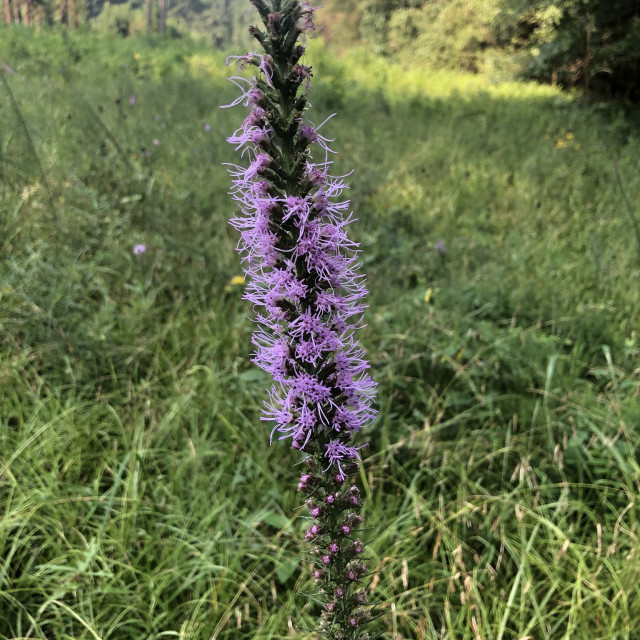NOMBRE COMÚN
Prairie blazing star
NOMBRE CIENTÍFICO
Liatris pycnostachya
TAMBIÉN CONOCIDO COMO
Gayfeather
Familia de planta
Aster (Asteraceae)
Grupo de planta
Hierbas y flores salvajes
Las blazing stars son plantas de jardín populares por sus coloridos racimos de flores rosas o blancas en picos de hasta 5 'de altura. Esta especie es una famosa flor de jardín, ya que florece a fines del verano y puede permanecer en flor durante un mes. A diferencia de la rough blazingstar, que se encuentra en suelos más profundos y ricos y también en sitios húmedos, a menudo a lo largo de arroyos o humedales, pero puede darse a lo largo de vías férreas, campos y acantilados rocosos.
81 informes
31+
OBSERVADORES
81+
OBSERVACIONES
Sugerencias de identificación
Los dos tercios superiores de la prairie blazing star son una espiga de flores de color rosa púrpura, parecidas al thistle, lo que les dan una apariencia algo borrosa por los estambres blancos extendidos (partes de flores masculinas) y pistilos (partes de flores femeninas). La floración comienza en la parte superior de la espiga y se mueve progresivamente hacia abajo. Cada cabeza de flor a lo largo de la espiga está formada por 5 a 12 floretes tubulares.
¿Sabías?
p> Las flores en la parte superior de las espigas de la prairie blazing star son las primeras en florecer. La floración progresará lentamente por la espiga. Las flores suelen florecer a finales del verano y principios del otoño. ¡Se trata de una gran especie sobre la que informar durante la campaña Fall into Phenology!
DISTRIBUCIÓN EN ESTADOS UNIDOS
Arkansas
,
Delaware
,
Iowa
,
Illinois
,
Indiana
,
Kansas
,
Kentucky
,
Louisiana
,
Massachusetts
,
Maine
,
Michigan
,
Minesota
,
Mossouri
,
Mississippi
,
Dakota del Norte
,
Nebraska
,
New Jersey
,
New York
,
Ohio
,
Oklahoma
,
Pennsylvania
,
Dakota del Sur
,
Texas
,
Wisconsin
HABITAT
Prairie blazing star prefers prairies and rocky, open areas including bluffs. They tolerate sun and moist to dry soil conditions, although it can tolerate moister conditions than most other Liatris species.
ATRIBUTOS
Hojas
"Pychnostachya" in the scientific name comes from the ancient greek for "crowded" or "dense" and equally refers to the leaves and the flower heads. Leaves are thus dense along the stem but are then and grasslike in appearance. Near the ground leaves can grow up to a foot long and 1/2 inch wide, but closer to the flowers leaves are much smaller, sometimes only an inch long and less than 1/8 of an inch wide.
Flores
The flower heads of prairie blazing star are small, at about 1/3 inch in diameter, and contain 5-10 florets. Each floret produces one fruit that may or may not contain a seed. Florets are pinkish purple to lavender or occasionally white. Long anthers and styles protrude from the florets giving the appearance of the flowers having purple hairs coming out of them! The bracts, which wrap around each flower head and are visible particularly before flowering begins, are pinkish red, narrow at the tips, and curly, which distinguishes this species from others in the same genus.
Frutas
The fruits of prairie blazing star are small, dry, achenes, like miniature sunflower seeds that are narrower and shaped more like coriander seeds with a tuft of fluffy hair called a "pappus" on one end of the seed which helps it disperse in the wind.
Tiempo de floración
Prairie blazing star can bloom July through December depending on the state. In the northern part of the range, it starts flowering earlier and ends by late September, well before frost sets in.
See Menu ES
- 2021 Chicago Botanic Garden. Todos los derechos Reservados.
-
Creative Commons
BY-NC-SA 4.0 - Terminos de uso
- Política de privacidad
- Políticas de uso compartido de datos y citas
- 2021 Chicago Botanic Garden. Todos los derechos Reservados.



